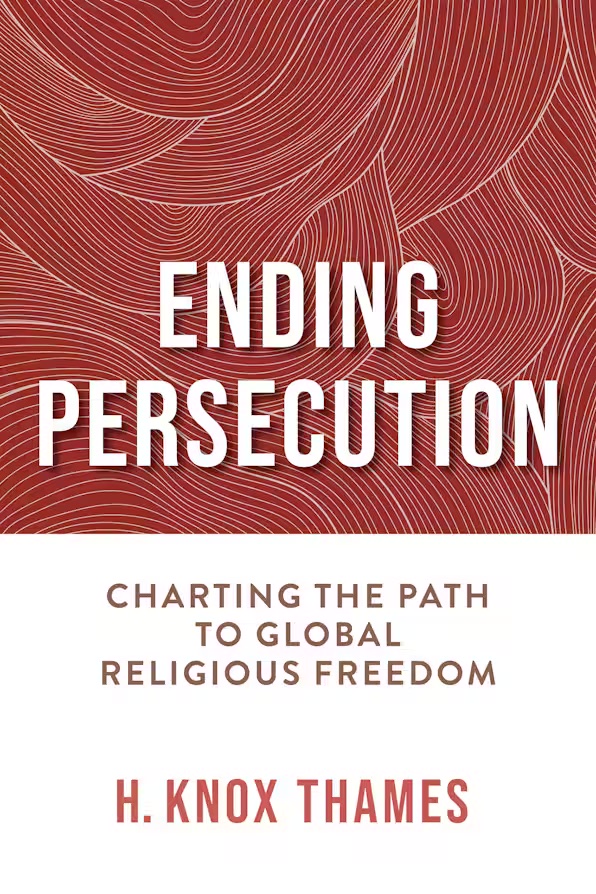Ending Persecution: Charting the Path to Religious Freedom by H. Knox Thames. Notre Dame, IN: University of Notre Dame Press, 2024, 416 pages. ISBN-10: 0268208670, ISBN-13: 978-0268208677. Available from Press and Amazon.
Reflecting on 20 years of service as a diplomat and advisor to multiple US administrations, international human rights lawyer Knox Thames lays out a vision for how governments, legislatures, NGOs, and religious leaders can work together to combat religious persecution globally.
In a book that is at once a memoir, a human rights textbook, and a manifesto, Thames outlines the scope of abuses, with personal anecdotes and observations from across the globe. He takes the reader through the halls of the US State Department and across the deserts of Afghanistan and Iraq, inside UN conference rooms and presidential palaces. Along the way he points out how various actors have attempted to confront persecution and promote religious freedom, explaining what has worked and what hasn’t, and why.
Legal Foundations
Thames opens his book with a look at the legal and political mechanisms put in place in the US through the passage of the 1998 International Religious Freedom Act (IRFA) and the foundational UN documents that address freedom of religion and belief. This chapter highlights the pivotal role of US diplomats in combating blasphemy laws and other distortions of the human rights mechanisms at the UN. It also highlights the clash between countries that claim the right to protect their own unique religious beliefs and countries that prioritize individual freedom to choose or not choose religion.
Following a discussion of genocide as it relates to cases of religious persecution, Thames turns to the difficulty of applying the available legal remedies, given conflicting agendas at both the national and international levels. He notes that commercial interests invariably trump religious freedom concerns in dealing with offending nations. Thames also addresses the ability of UN member states to use mechanisms such as the Human Rights Commission to subvert religious freedom. Here Thames singles out China as “the best of the worst” in terms of exploiting the power of the UN to defend domestic abuses and promote its own understanding of human rights (55).
Having stated the book’s overarching theme, “the United States should speak up for those persecuted for their beliefs,” (6) Thames spends the next chapter challenging the US to wield its considerable diplomatic clout more effectively in the defense of religious freedom. The bulk of the book he devotes to delineating four types of repression and ways to counter each. Central to Thames’ argument is the intersectionality of religious freedom, which he calls “the cornerstone of democratic society.” (4) Because it is inextricably tied to other social and political dynamics, religious persecution can only be countered through a multi-faceted strategy that addresses these underlying factors.
Causes and Remedies
Tyrannical democracy, the first type, is found in states like India, where the Hindu-led government condones violence against other religions, as well as Hungary, with its far-right pro-Christian government that vets religious groups based on their political stance. Without protection of minority rights, illiberal democracies can become dictatorships. Thames proposes responding to these two types of abusive regimes with the “four-legged stool” referred to above, consisting of diplomacy, legislation, and the advocacy and action of NGOs and religious leaders. While the unique factors affecting different religions need to be acknowledged, this response must be aimed at securing freedom for all, a theme to which Thames returns repeatedly throughout the book.
Violent extremism, the third type, occurs at the hands of religious leaders who leverage their cultural influence to seize political power and attack those of other faiths. Here Thames mentions the long history of religious conflict in Pakistan and Sri Lanka, along with the role of fear-mongering Christian leaders in the US in fomenting the violence that shook the capital on January 6, 2021. Using the term “extremist climate change,” Thames warns, “Politics is downstream of culture. When cultural climate changes through extremism, the metamorphosis can have long-lasting consequences in democracies and other nations.” (221) Thames proposes education as the solution, including cultural heritage projects to help people of various faiths recognize their countries’ varied traditions and addressing discrimination in school curricula.
Finally, terrorism concerns the violence of religious groups such as the Islamic State, al Qaeda, and the Taliban. Exploring the role of military intervention in providing security for religious minorities, Thames looks specifically at the need for political and military leaders to take into the account the religious dimension of conflict. Blindness to this dimension, Thames warns, can lead to ill-advised alliances with extremist religious groups or to neglecting the plight of endangered religious minorities.
Thames concludes with a list of recommendations, beginning with the need for consistent application of rights standards, building international coalitions, specifically calling out regimes for religious freedom violations, and backing up threats with concrete actions like sanctions. He then turns to US-specific proposals for Congress and the diplomatic establishment, including an overhaul of the 25-year-old US Commission on International Religious Freedom (USCIRF) that was created when the IRFA went into law.
China’s Impunity
Although Thames’ focus is primarily on other countries, China stands out for its impunity, made possible by the inaction of the world community, which, Thames says, has simply stopped responding. Thames singles out China for its economic clout, which discourages nations from standing up to rights abuses. This is particularly true of the “Belt and Road” countries, which fear losing economic benefits if they criticize China. Thames notes that many of these same nations are willing to address human rights abuses in other less powerful countries but not in China.
Within Thames’ typology, China fits the definition of a dictatorship—one that has become increasingly immune to outside pressure. Government leaders and legislatures are often reticent to take action against China when economic interests are at stake. The days are long gone when simply calling out China would prompt positive action by officials sensitive to world opinion. So are the opportunities for NGOs to meaningfully interact with government and civil society in China. China’s United Front system is quick to parse foreign religious leaders who are “sympathetic” versus those who seek to embarrass China by criticizing rights abuses. When it comes to China, the four-legged stool appears to be broken.
No Silver Bullet
Thames is clearly a Washington insider. While the book is understandably directed at US policymakers, readers from other parts of the world (or of the US for that matter) may find the lengthy rhetorical excursions into “inside the Beltway” intrigue a bit tiresome.
On a more serious note, Thames’ insistence that the US must take the lead in countering religious persecution may strike some readers as problematic. Arguing for the US’s “exceptional” role, given the historical tension between church and state and the US’s unique approach to religious liberty, Thames writes, “Our complicated history actually positions the United States to convincingly speak about human rights” (24).
Events at the time of this writing, however, raise the question whether the US, under the current administration, is still in a position to exercise the requisite moral authority and leadership by example, particularly given its own disregard for minority rights at home and its withdrawal of support for many who have been on the frontlines of religious freedom advocacy overseas. Thames himself sounded the alarm recently about the loss of US influence due to the administration’s freeze on foreign aid, the demise of the US Agency for International Development (USAID), and the suspension of refugee resettlement, all of which he sees as devastating to the promotion of religious freedom abroad.
Ambitious title aside, Ending Persecution does not offer a silver bullet or a one-size-fits-all approach to achieving religious freedom for all. For reasons Thames details in the book, these do not exist. This volume does, however, provide a comprehensive overview of the state of religious freedom globally and a guide to the underlying causes and possible remedies for persecution. It also points out candidly where these remedies have failed. By mapping the complex legal, cultural, and political ecosystem in which persecution occurs, Thames enables individual actors, whether in government, academia, the NGO sector, or religious bodies, to find their roles in collaboratively addressing offenses against religious believers.
Our thanks to University of Notre Dame Press for providing a copy of Ending Persecution: Charting the Path to Religious Freedom by H. Knox Thames for this review.
Image credit: Natalia Blauth via Unsplash

Brent Fulton
Brent Fulton is the founder of ChinaSource. Dr. Fulton served as the first president of ChinaSource until 2019. Prior to his service with ChinaSource, he served from 1995 to 2000 as the managing director of the Institute for Chinese Studies at Wheaton College. From 1987 to 1995 he served as founding …View Full Bio
Are you enjoying a cup of good coffee or fragrant tea while reading the latest ChinaSource post? Consider donating the cost of that “cuppa” to support our content so we can continue to serve you with the latest on Christianity in China.
